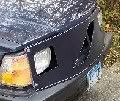|
Folks up north know the secret well.
For going in snow, you want the tallest (highest aspect ratio) and narrowest tire! Really -- ask anyone from Canada or New England. Best for standard steel wheels would be a 175-14 (which is an 83 aspect ratio) if you can still find it (doubtful), so find a 175/75-14.
Forget low and wide -- that's fine for floatation (e.g., in sand), but you don't really want floatation in snow! Surprised? Here's why:
Sand has the same density throughout the depth (top to bottom) -- there no advantage sinking low (it's as loose deep as it is on top), so staying on top of the sand (floatation) at least lessens the resistance you have to overcome to get (or keep) moving, despite having little for your tires to push against to move you forward.
Snow is different. Snow is denser as you go deeper, and you want the lugs of the snow tires to reach the densest, more rigid packed snow underneath for the tires' lugs to engage and push against! A snow tire on top of snow just spins the flakes around, but if it sinks down, it can get you going. However, it will also have to push the surrounding snow out of the way -- that's where a narrow tire (like the bow of a boat) will have less snow to push aside (like a plow) than a wider tire, so it will have less resistance to overcome.
Good luck.
|

